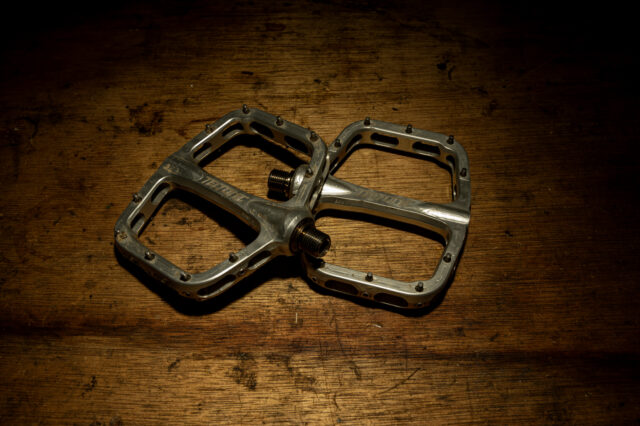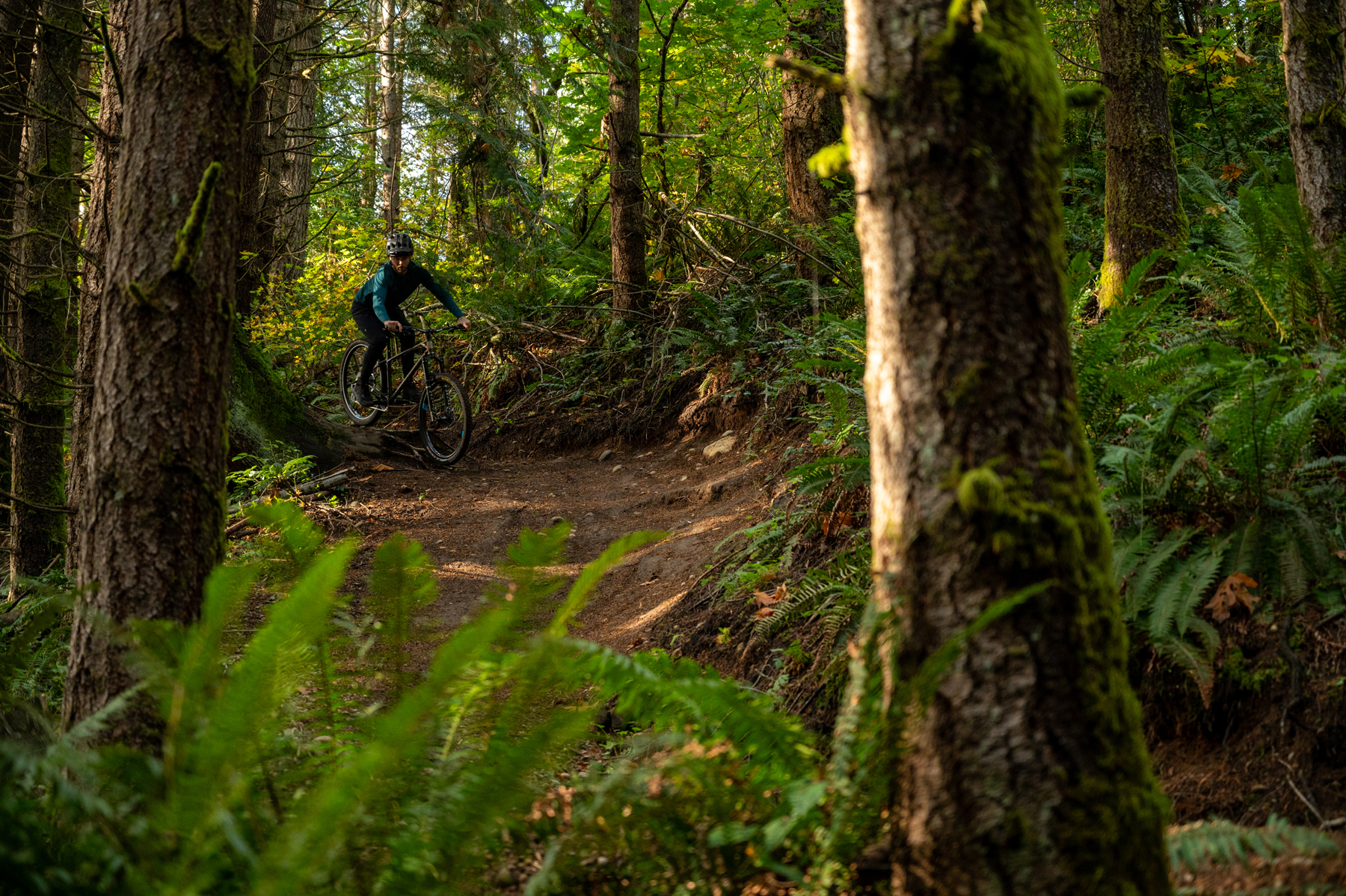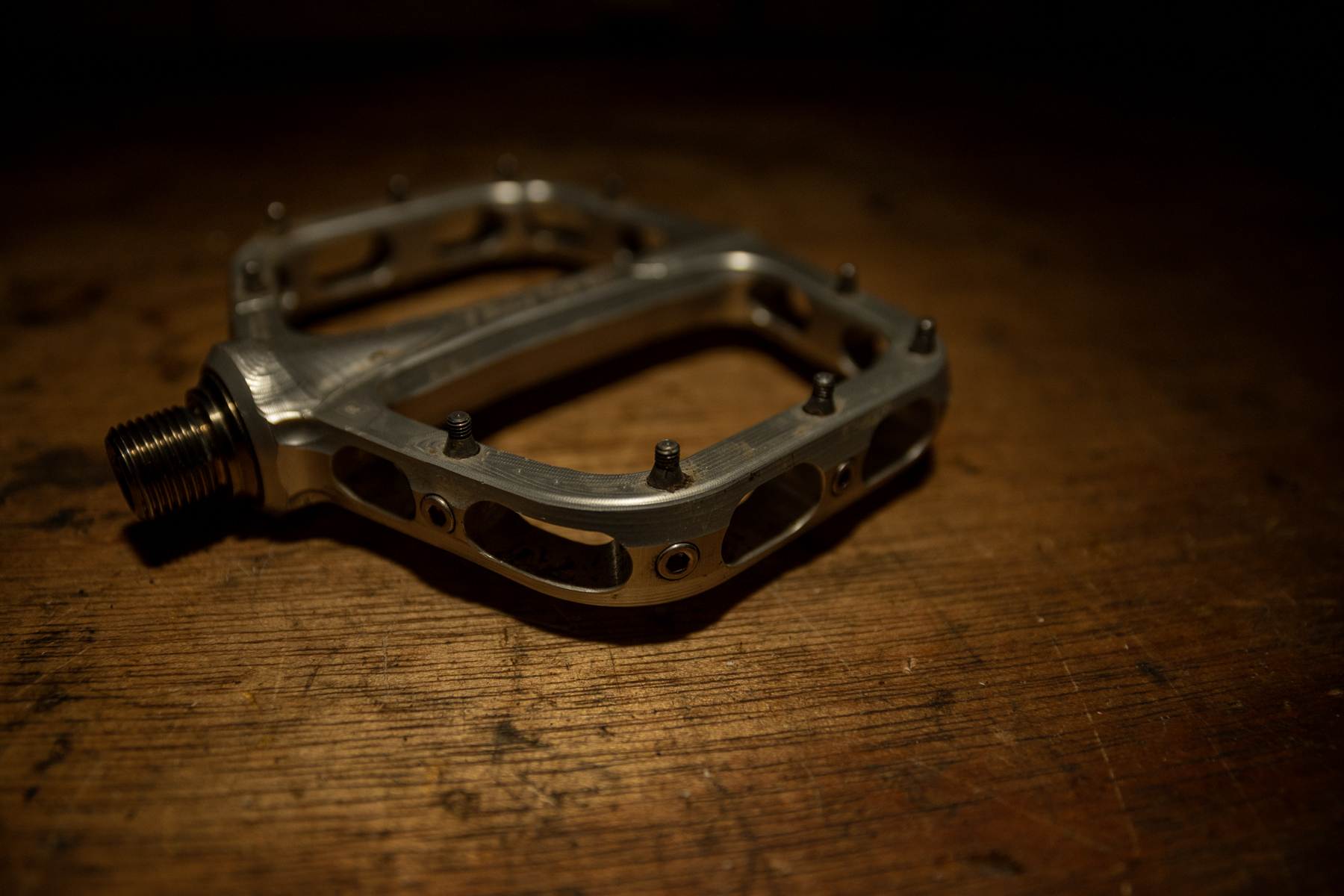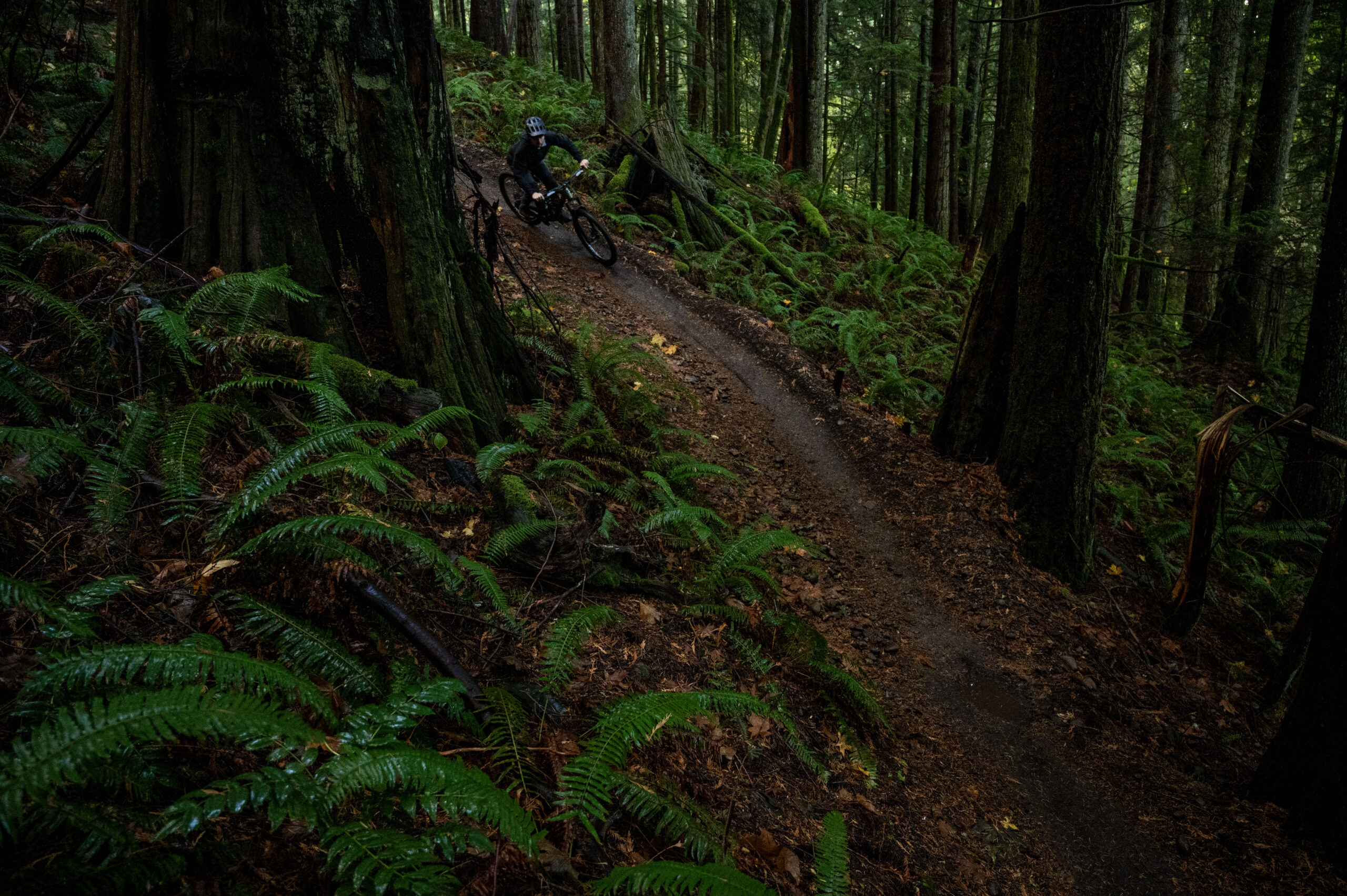Tectonic Altar V2 Pedals
Platform Dimensions: 112.5 mm [W] x 125 mm [L]
Platform Thickness: 13.6 mm (center); 17 mm (front and back edges)
Pin Count: 10 per side
Pin Height: 5 mm
Blister’s Measured Weight per Pedal: 204 and 205 g
MSRP: $199
Test Location: Washington
Test Duration: 3 months
Reviewer: 6’, 170 lb / 183 cm, 77.4 kg
Shoes Used: Five Ten Freerider Contact, Five Ten Trailcross GTX

Intro
It’s rare to see what feels like a truly new design concept in flat pedals. That’s not to say that they’re all the same by any stretch — subtle-seeming tweaks in platform shape, pin design / placement, and so on have a very big impact on how a pedal feels and performs — but for the most part, the layout is fairly well standardized.
So Tectonic caught our eye with their Altar pedal, which uses a novel pin design that’s not like anything we’ve seen elsewhere. But has Tectonic successfully reinvented the wheel, or is their unconventional design just a quirky one?

Design
Let’s start with the most interesting part of the Altar V2: the traction pins. Every other flat pedal I can think of (at least ones meant for real mountain bike use) uses some sort of threaded pin, be it a set screw, a cap screw, or some more complex custom piece that threads into the pedal body directly. That style of pin can work great when it comes to providing grip and pedal feel, but can also be a real headache when the pins get damaged and need replacing. Broken set screws can lose their hex driver and need to be drilled out; bent pins may be too mangled to unscrew cleanly; and the threads in the pedal body itself can be damaged in any number of ways, too.
The Altar’s pins work completely differently. They’re double-sided, with a single pin protruding on both sides of the pedal, and instead of threading into the pedal body, they slip into a hole going through it and are secured by a cap screw that screws into the pin from the front face of the pedal. It’s probably a lot easier to explain with a photo, so here you go:

That arrangement has a few advantages. For one, the pins are supported across the full thickness of the pedal platform (in contrast to most conventional designs, where there are just a few millimeters of thread engagement) so there’s far less chance of a pin getting ripped out or otherwise damaging the pedal body. The pins can also be removed from either side of the pedal, so a damaged one should be easier to remove, and have a much larger diameter in the middle where they engage with the pedal body so they’re (1) stronger there and (2) have some room for the tip to get bent before it makes removal in either direction a problem.
There are ten pins per pedal, with three longer pins along the leading and trailing edges of the pedal body, and four shorter ones positioned closer to the spindle. The shorter pins are sized to match the taper of the pedal body thickness, but both pin lengths protrude 5 mm from the pedal body at their respective locations. All are set around the perimeter of the pedal (i.e., none anywhere near the middle of the platform). They’re made of hardened stainless steel and are threaded at the tips for improved grip. The proprietary design does of course mean that you can’t just walk into a hardware store and buy replacements, but Tectonic sells a pin kit (with enough for a single pedal) for $9.
The Altar V2 uses a machined aluminum body that’s 13.6 mm thick at the center, and 17 mm thick at the leading and trailing edges. There’s a subtle bulge on the outboard side for the bearings (16.3 mm thick) and a larger one for the inboard bearing (26.6 mm diameter at the very inboard end, but it tapers thinner as you move outboard). The platform is notably long, with a 125 mm usable length, but not super wide at 109 mm (including the bearing bulge) or about 98 mm for the more useable part of the platform. From the crank-arm mating face on the spindle to the outer end of the platform measures 112.5 mm. The Altar’s unusual pin arrangement means that there’s no offset between the upper and lower faces of the pedal — since the pins serve double duty on both sides of the pedal, the top and bottom faces need to be aligned to maintain symmetry.

[For those wondering, the Altar V1 used basically the same design but with a carbon-fiber-reinforced plastic body. Tectonic says they pivoted to the aluminum body when they ran into issues with inconsistent part quality from their original molds for the CFRP V1 bodies, but they think that material still has merit and that they hope to bring a revised version of it back down the line.]
The Altar V2 pedals use a stainless steel spindle and spin on four cartridge bearings per pedal (one 6801 on the inboard end, and three MR115s at the outboard side) with an O-ring at each end to further protect the bearings from the elements. The bearings are fairly standard sizes, but Tectonic also sells a full bearing kit (including replacement O-rings and lock nuts) for $16.
The Altar pedals are machined and assembled in Durango, Colorado. Tectonic offers a lifetime warranty for the original owner to cover cases of manufacturing defects and a crash replacement policy on a case-by-case basis for damage that falls outside that scope.
On the Trail
To cut to the chase: the Altar V2 is one of the grippier flat pedals I’ve tried to date, with the hyper-aggressive Chromag Dagga being the only one that’s a clear step up on that front. The Specialized Boomslang is probably close in terms of outright grip, but it’s tough to exactly assess because their platform sizes and pin layouts aren’t at all similar, and they feel very different overall as a result. The Altar V2 is appreciably grippier than the Hope F22 or NSB Daemon, for example, and while it’s harder to reposition your feet on than many less-aggressive pedals, the Altar V2 feels fairly easy to work with on that front for its overall level of grip.
The Altar feels moderately concave and my foot settles nicely into the middle, though the bearing bulge does start to become noticeable if I wind up with the ball of my foot close to the pedal spindle. I’d generally prefer to have my foot a little farther forward on the pedal anyway, and in that position, the bearing bulge ends up landing inboard of the forward part of my instep, where my foot doesn’t contact it and it’s no longer noticeable. The Altar does feel a little more sensitive to foot placement than some other pedals as a result, but if you prefer to have the ball of your foot forward of the pedal spindle as I do, it works nicely.

I also really like the dimensions of the Altar platform. I think it’s the longest flat pedal I’ve tried to date, and though my feet aren’t super huge (I’m usually a US size 10 / EU ~43.5), the support that the notably long platform offers feels excellent. The fact that the Altar pedals aren’t massively wide is also welcome — I’ve noticed appreciably fewer pedal strikes as compared to the Chromag Dagga, in particular. I spend a lot of time clipped in, especially in the summer, and my brain’s programming for where the limits of my pedal clearance are is definitely better tuned for those pedals than flats (even big DH-style clipless pedals have much smaller platforms than most flat ones). The Altar’s platform is wide enough to give good support for my feet without sticking out farther than it needs to. Folks with super big / wide feet might want a little more width, but I’m a fan of the Altar on that front.
I haven’t historically loved flat pedals without any offset between the upper and lower faces (e.g. the Deity T-Mac) because I tend to find that it makes me more prone to rolling my feet off the front of the pedal while pedaling, but the extra length of the Altar’s platform (and probably also the overall high level of grip that they offer) has taken care of that issue for me nicely — I’ve had no such issues here. Compared to pedals with some forward offset (e.g., Chromag Dagga, NSB Daemon, Hope F22), the Altar V2 does feel like it generates a higher proportion of its grip from the rear pins than the forward ones, but I got used to that sensation fairly quickly.
It’s a tough feeling to explain clearly, but the best way I can put it is that, on pedals with a bit of forward offset, I tend to feel like the ball of my foot is landing fairly close to the middle of the useable platform, but on the Altars it feels appreciably forward of the middle of the pedal. That feel, plus the bearing bulge at the spindle, does make the Altar more sensitive to foot placement than some other pedals — too far back and the ball of my foot hits the bearing bulge, too far forward it starts to feel like the ball of my foot is well away from the center of the pedal’s concavity. But with my feet in the right spot, the feel and grip of the Altars are excellent, especially for a pedal that’s thinner and lower profile than the very biggest, grippiest options out there, like the Chromag Dagga.
Durability
The Altar pedals haven’t given me any trouble in about three months of regular use so far. The pedal bodies have some scuffs, as to be expected (though the clear anodized finish hides them pretty well) and I haven’t yet managed to damage any pins. The bearings are still spinning smoothly and while the grease on the spindles does show a little bit of contamination, it’s not bad at all (and the Altars have been out on some pretty wet days by now). We’ll see how the bearings hold up in the long run, and I’ll report back if any issues crop up prematurely. But the Altar spindles are easy to service and rebuild kits are cheap, and everything is going just fine so far.


Bottom Line
The Tectonic Altar V2s are an aggressive, grippy flat pedal with a notably long but not super wide platform that offers a lot of support for my US 10-sized feet while being lower profile than many truly big pedals. And their unusual pin design has held up great and seems very promising when it comes to both long-term durability and the ability to replace mangled pins when the time comes. The Altar V2s are a little more sensitive to foot placement than some other pedals and their appreciable bearing bulge might not work well for folks who prefer to have the ball of their foot placed near the spindle, but if their layout works for you, they’re a compelling option.

I used to work in the shop in Durango where these pedals are made and I personally worked on the spindles, from raw material to heat treat. DMI is an awesome shop with solid folks. Curious what you disliked about the finish. We tested a bunch of different styles and I thought the finish they went with looked pretty sick on the V2s I saw. Super stoked to see Tectonic getting a shout in Blister. Andrew is a good dude and he’s hands on in the shop checking things out and personally testing prototypes